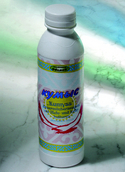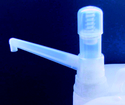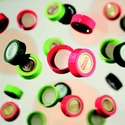Time for closure
19 May 2006The key factors governing the design of a good closure include tamper evidence, child safety, anti-counterfeit features, openability, dispensing and branding. Rod Abbott investigates
Over the years, suppliers of food, drink and pharmaceutical goods have been harmed enough by various tampering scares, so to what length does a manufacturer have to go to ensure its product is totally safe? How can anyone ever claim to have discovered the truly pilfer-proof package when many acknowledge that such a commodity does not exist?
The chances are they can’t and the future must be considered challenging with many questions still to be answered. However, the packaging industry’s advances in the field of tamper evidence have been well chronicled and progress is being made, as shown by some of the innovative developments described below.
Allgäuland-Käsereien is filling Kumyss, a traditional Eastern European style health drink, using Amcor White Cap's 38mm Plasti-Twist closure with liner. The white closure is reputed to be easy to open without any device, and easy and safe to reseal. It also features a patented drop-down tamper-evident band. The packaging is ideal for on-the-go consumption.
Amcor White Cap launched its 40mm Band-Guard closure in 2005. The cap is a Press-On Twist-Off (PT) style composite closure. It features a metal disc, with PVC-free liner, tamper-evident safety button and plastic outer shell, with drop down tamper-evident band.
The cap provides a dual tamper-evident indicator – band and safety button. The button pops up with an audible click during first opening when the vacuum is released. It provides a triple safety feature since the consumer can see, feel and hear the change. The drop-down safety band is visibly destroyed during first opening, providing clear evidence of tampering.
Crown Closures Europe also has an important recent launch in the composite closure/dual tamper-evidence market. The cap, called the Ideal, is suitable for use in the food and beverage sector and is said to be easy to open and to re-close. There is full seal integrity for all food processes and the cap features a drop down tamper-evident band. A vacuum safety button provides the dual tamper-evident feature. Ideal provides traditional metal barrier protection and plastic impact resistance, and is fully recyclable.
Dragon Plastics has launched its first plastic volumetric closure system, VolishoT, which comprises three snap fastenings and one screw fastening. Suitable for use with haircare products, it incorporates volumetric dispensing, mixing and tamper evidence. Removing the tear band and then pressing down on the top cap activates the system.
The desire to achieve the combination of tamper evidence and child resistance has been something that has taxed the minds of the industry for many years. Innovative developments in this field are now coming to fruition, some enhancing and improving closure solutions originally developed in the 1990s.
For example, UCP has developed PP28mm Medi-Loc, a child resistant tamper-evident closure for the pharmaceutical market, which has passed the demanding protocol testing standards for child-resistant packaging under ISO 8317: 2003, which came into force in October 2005.
Adapted from UCP’s Clic-Loc child-resistant closure technology with the addition of the Vistop tamper-evident ring, Medi-Loc is a more compact closure than that originally developed in the 90s for the liquid pharmaceuticals market, achieving a 30% weight saving. As the Vistop tamper-evident ring is a separate assembly, closures can be supplied with the ring in a contrasting colour.
While the option to use shrink sleeves fitted over a metal or plastic cap is still finding favour some users are moving away from this solution. One such case in point is Thornton & Ross, which has replaced standard screw closures and shrink sleeves on Covonia cough linctus and other liquid pharmaceutical products with UCP’s PP28 tamper-evident closure.
Thornton & Ross claims that using PP28TE combined with a Vistop tamper-evident band has ensured a cost-effective and efficient tamper-evident closure system and also obviated the need for an additional sleeving operation.
The pack maintains child resistance through first and subsequent use.
Branding does well in the luxury goods sector, but may not always be evident in all aspects of other product sectors. One leading designer, however, feels progress is being made in closure design: “Closures are playing a bigger role visually and in terms of interaction,” says head of packaging at PDD Miles Hawley, signalling the wide neck, upturned Heinz tomato ketchup bottle as a good example. The wide base, ever-ready orientation and the cleanliness and efficiency of the split valve sauce delivery system add up to a positive physical interaction with the Heinz brand.
“Long before any physical interaction, however, closures and packs generally are necessarily geared to standing out, on sight, at point of sale and point of purchase in the first 0.5 seconds. P&G's 'first moment of truth' is a useful perspective during development of closure and pack design here at PDD.
“The rise of bottled water is a good example of this sequence of experience. Re-sealable sports caps quickly became standard across most water brands.
Subsequently, these brands – in particular Evian – have abandoned off-the-shelf closures for visually innovative and striking closure elements that, in some instances, emulate the perfumery sector.
“This is a sure measure of the rising status of closures in the brand equity mix. Some sectors stand out for the elaborate closures they deploy and the dosing, spraying, safety and ergonomics considerations of weedkiller solutions in particular offer a model for the future in other sectors.
“Innovation need not be highly technical. The universal coffee cup cover with hole for drinking has become indispensable to brands like Starbucks in expressing the on-the-go lifestyle aspirations of the brand.”
Global Closure Systems (GCS) vice-president Colin Jones believes that integrated valve closures can be a key component to enhancing a consumer's product experience. Why? “Convenience is king in many consumer products and valves, very simply, address this issue head on,” he says.
“By making a product easy to use, consumer product companies have a differentiator to attract consumers. Marketeers often use a valve feature to advertise the convenience of a product in order to attract first time customers and retain brand loyalty.
“We break down convenience into control of the product and reliable dispensing of the product. For instance, inverted containers allow product to be available immediately when the consumer wants it. Bottles for shampoos, conditioners and shower gels are a great example. Consumers have been turning these packs upside down for a long time in order to maximise product usage and the efficiency of dispensing.”
GCS offers various valve technologies suitable for food, beverage, personal care and household applications through its standard Zelvalve range of closures as well as valve technology for the spirits market through UCP Scotland.
Valve technology can control the dispensing of products, but it can also prevent the refill of a container after a container has been emptied or while it is being used. UCP’s fitments for the spirits market consist of polystyrene valves made up of six parts ultrasonically welded to appear as an integrated part of a spirits bottle. The valve is gravity activated so flow is stopped in either direction when the bottle is vertical. Flow only occurs when the bottle is at an angle, giving the customer a controlled pouring experience and also ensuring that refilling is very difficult.
Rieke Packaging Systems Englass has launched a new range of airless dispensers for products of different viscosities, including creams, lotions and gels. The new airless dispenser range offers a choice of two designs – slim-line or wide-bore.
The slim pack is available in 50 and 100ml and the wide-bore pack in 50, 100, 150 and 200ml sizes. Both pack sizes deliver optional doses of 0.5, 1, 1.5 or 2ml. The dispensers are available in natural, transparent and coloured combinations with a variety of decoration options to enable them to be personalised to individual brand requirements.
The company has also introduced a new version of its FND30 dispenser in clarified PP that allows users to see the liquid through the dispenser as it is being pumped. It reflects a move to clear containers in a number of markets including food, household products and pharmaceuticals.
RPC Bebo Plastik has developed an innovative lid in conjunction with Hälssen & Lyon, one of Europe’s leading tea manufacturers, that solves the traditional problem of what to do with tea bags during ‘on the go’ drinking. The new “tea-to-go” concept avoids this difficulty by keeping the bag inside the cup for the duration of consumption. When the desired brewing time is reached, the tea bag is pulled out of the drink into a special compartment in the lid by means of a cardboard flap attached to the bag. Once the drink is finished, the cup can be disposed of with the bag still inside.







